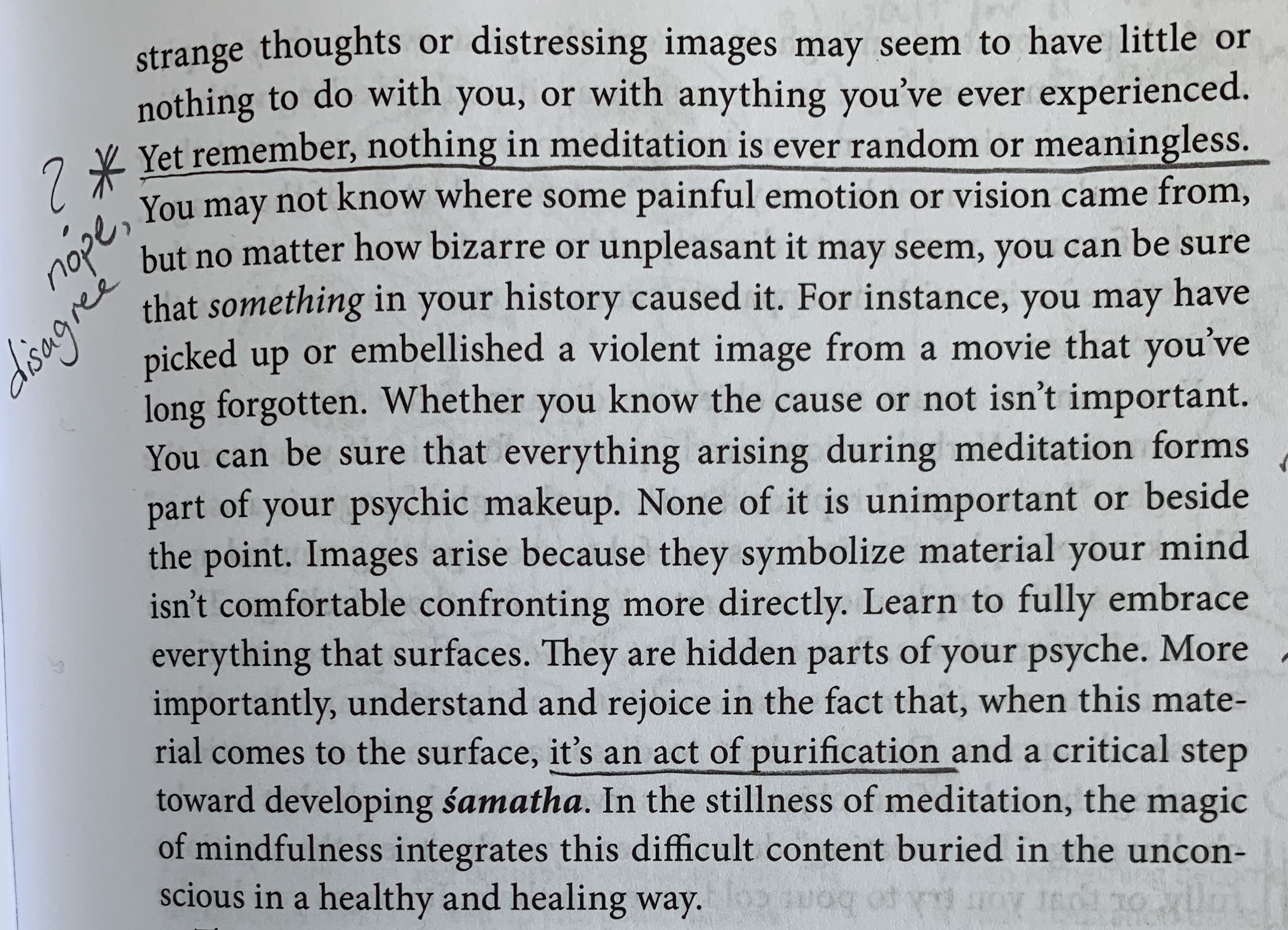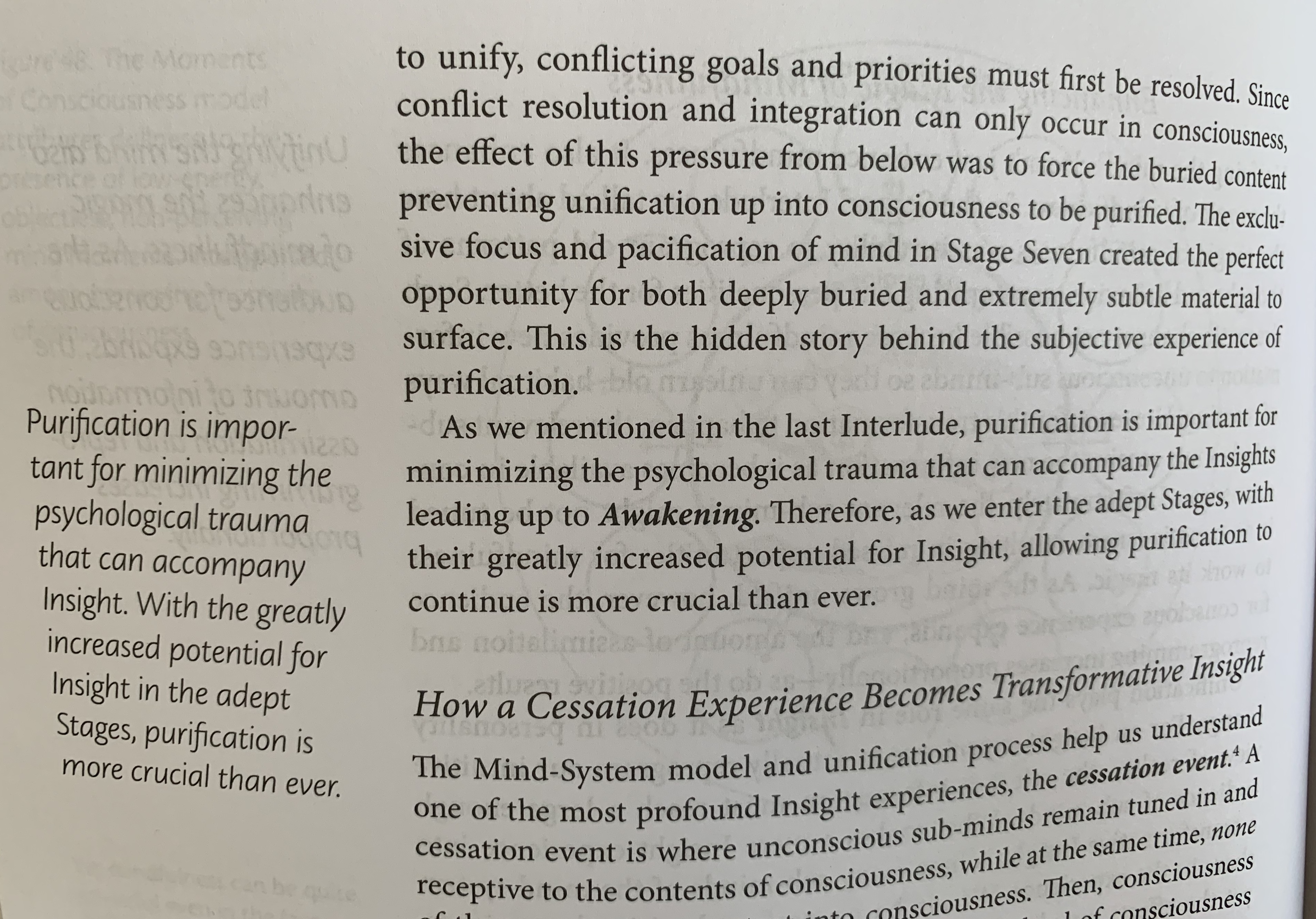
The Mind Illuminated, Stage 4, p. 135

The Mind Illuminated, Seventh Interlude, p. 284
These are reflective notes on my experience of practicing Culadasa’s 10 stage meditation system. For an introduction to this project, see this page.
Purity and impurity
Like most śamatha-vipassana systems, The Mind Illuminated is big on purification. The system itself views meditation as a method by which the mind is purified. The modern Buddhist view is that some experiences (e.g. unpleasant emotions such as hatred, anger, irritation and discomforting experiences such as suffering and resistance to pain) are inherently impure; that is, they are unwholesome and therefore bad for us. Other stuff arising in our meditation and daily lives is inherently good for us: for example patience and calm, joy, tranquility, equanimity.
This is an aspect of the Sutric heritage. Traditionally in Sutrayana all worldly, embodied experience was viewed with contempt. Disgust with physical, emotional, human experience was actively cultivated. The dividing line between pure and impure shifted in different circumstances. Physical pleasure was traditionally viewed as inherently impure and as a “fetter” that ties you to the world. However, sometimes ‘sukha’, happiness, bodily pleasure, bliss, is adopted into the pure side of the dichotomy as a positive stage in development. In Sutric systems it is always eventually dropped and superseded by tranquility and ultimately equanimity, seen as higher attainments.1
To take this view means that everything arising in experience is assigned some meaning along a scale of pure to impure. The greater the impurity or purity assigned, the stronger the felt meaning. Worldview and practice self-reinforce: the more we adopt this worldview, the more we define our experience in terms of the continuum of purity and impurity, good and bad, pleasant and unpleasant. Purity-stance is itself a form of conditioning. We condition our visceral response to pleasurable sensation when we perceive purity, physical contraction and disgust when we perceive impurity.
With the prior view that some mental or emotional experiences are harmful, negative and undesirable and that others are beneficial, wholesome and desirable, the natural follow-on in meditation is to disregard negativities and encourage positive arisings to flourish. Purification-view takes this process a step further: it says that the act of meditation cleans our mind of undesirable, unpleasant experience. Meditation creates the mental and emotional space for hidden negativities to arise. What happens then is somewhat mysterious: the act of ignoring gradually replaces impure stuff with pure stuff, or by being seen it is ‘integrated’ and therefore no longer impure. In any case, the good stuff increases in stature and space, the bad stuff diminishes until it is no more.
For this to work in meditation we must be willing to regard some experiences as impure, therefore undesirable and others as pure and good. Disambiguating experience in this way can sometimes be useful. I think it’s particularly helpful for practicing personal boundary formation if you have had some difficulty setting boundaries, for example, due to addiction. In such circumstances clearly delineating pure from impure, healthy from unhealthy experience could be just right.
Meditating with a purity skew can feel really, really good. Up to a point, the more you ‘purify’ your mind through meditation, the better it feels. With some diligence, it’s possible to get to the point where you feel pleasant and calm most of the time, unaffected by the tumult of unpleasant life experience. The goal of most śamatha-vipassana paths is to become unaffected by the suffering of the world all the time, experiencing only ‘upekkha’ – equanimity.
I think the increased emotional and physical sensitivity that this kind of meditation leads to is largely beneficial. However, it comes with a big downside. This dualizing stance increases repressive control-freakishness; it can lead to disassociated, cold judgementalism. One cannot view some emotions and experiences as inherently impure for long without developing a controlling mindset. Starting with directing a response to what arises mentally and emotionally, we then begin dictating what behaviour is good or bad in ourselves and others. Practitioners with purity issues start controlling their contact with others in terms of impurity contagion risk. They may seem rigidly separate, unwilling to let go and relax, or locked away from messy, ambiguous interrelatedness in a bubble of pleasurable disassociation.
Setting meditation inside a purifying framework is not common to all meditation systems. In the four naljors meditations one regards whatever arises without positive or negative skew: all thoughts, emotions, sensations, ideations are categorically the same from the meditative perspective: random arisings. According to this method, no arising is ascribed any particular significance.2 This difference in method derives from different worldviews. Karma – the idea that all mental, emotional and physical events are causally linked – is central to the Sutric worldview. Dzogchen explicitly rejects this notion.
Śamatha-vipassana can be a quick and effective path to increased sensitivity, calm mind and spacious experience. However, anecdotally one of the common difficulties for experienced śamatha-vipassana practitioners approaching Vajrayana practice is letting go of a dualistic purity-impurity, right-wrong, good-bad internalization whilst retaining the sensitive response learned from it. Experience is intricately entwined with view. Nonetheless, the personal worldview that upholds experience is often invisible. It’s constructed with priors we adopted without realizing, some time long ago when all we were doing was following instructions.
- 1.Purification was also important in the outer Tantras, but the logic and function were somewhat different.
- 2.This is the meditation method, which loosens reliance on points of reference. Unlike samatha-vipassana meditation, shi-ne is not regarded as an appropriate practice for everyday, ordinary life. It is confined to formal sitting practice, though it may lead to naturally arising non-ordinary experiences off the cushion. The Dzogchen worldview accounts for randomness and causality as interweaving facets of experience.
